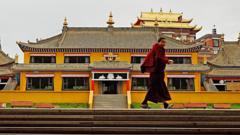In the heart of Sichuan province, the Kirti monastery stands as a silent witness to Tibetan resilience against the oppressive shadow of the Chinese Communist Party (CCP). Recently, a courageous monk approached us, revealing the grim reality for Tibetans: "Things here are not good for us,” he confided, despite the risk of surveillance from eight unidentified officials.
The monastery has gained notoriety for its role in Tibetan resistance over the years, particularly during protests against Chinese rule in the late 2000s. Today, it remains a source of anxiety for Beijing, which has fortified its presence with police stations and invasive surveillance. The monk's warning resonates as we navigate a compound observed by cameras, underscoring the tension that permeates their daily lives.
The situation in Tibet has only grown dire since the annexation of the region in 1950. As the CCP asserts control, Tibetans who have escaped share harrowing stories of cultural erosion and systematic oppression. The exiled Dalai Lama, once a guiding beacon for Tibetan identity, faces stringent restrictions against his image within Tibet and is labeled a separatist by the Chinese government.
While the Dalai Lama celebrated his 90th birthday, the question of his succession looms larger than ever. Gatherings in Dharamshala mark the significance of this moment for Tibetan Buddhists. However, inside Tibet, any vocal support for the Dalai Lama could be met with severe consequences. A monk shared, “That’s just the way it is... that's the reality.”
In recent years, the government has imposed stringent regulations on education and cultural expression within Tibetan schools. Tibetan children, barred from receiving proper instruction in their own culture until they are 18, are forced into a system that emphasizes loyalty to the state over their religious heritage. Renowned scholar Robert Barnett warns of a grim future where Tibetan Buddhism faces overwhelming limitations amidst an increasingly oppressive landscape.
As we traversed the road to Aba, the modern developments funded by the CCP juxtaposed the rich heritage of Tibetan culture. Promoted as a harmonious blend of cultures, the reality shows a systematic attempt to erase Tibetan identity—surveillance pervades their every interaction, even the mundane act of buying petrol becomes an exercise in surveillance.
Tensions are mounting as the Dalai Lama indicated his successor would be chosen after his passing, suggesting a potential struggle between the exiled Tibetan leadership and the CCP’s plans for a state-sanctioned successor. Beijing’s efforts to manipulate the narrative surrounding the Dalai Lama’s successor have already begun, aiming to bolster its authority over a culture it seeks to reshape.
The ongoing fight for Tibetan identity, threatened by years of oppressive governance, faces an uncertain future. The Tibetan spirit, however, remains resilient, as seen in the song and smiles of the women passing the prayer wheels in the monastery—a poignant reminder of a culture standing firm against adversity. The true test lies ahead: preserving Tibetan heritage and beliefs even as the very embodiment of their resistance, the Dalai Lama, prepares for his departure from this world.



















